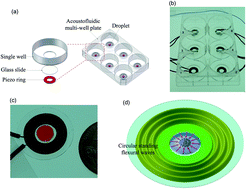Acoustofluidic multi-well plates for enrichment of micro/nano particles and cells†
Abstract
Controllable enrichment of micro/nanoscale objects plays a significant role in many biomedical and biochemical applications, such as increasing the detection sensitivity of assays, or improving the structures of bio-engineered tissues. However, few techniques can perform concentrations of micro/nano objects in multi-well plates, a very common laboratory vessel. In this work, we develop an acoustofluidic multi-well plate, which adopts an array of simple, low-cost and commercially available ring-shaped piezoelectric transducers for rapid and robust enrichment of micro/nanoscale particles/cells in each well of the plate. The enrichment mechanism is validated and characterized through both numerical simulations and experiments. We observe that the ring-shaped piezoelectric transducer can generate circular standing flexural waves in the substrate of each well, and that the vibrations can induce acoustic streaming near the interface between the substrate and a fluid droplet placed within the well; this streaming can drive micro/nanoscale objects to the center of the droplet for enrichment. Moreover, the acoustofluidic multi-well plate can realize simultaneous and consistent enrichment of biological cells in each well of the plate. With merits such as simplicity, controllability, low cost, and excellent compatibility with other downstream analysis tools, the developed acoustofluidic multi-well plate could be a versatile tool for many applications such as micro/nano fabrication, self-assembly, biomedical/biochemical sensing, and tissue engineering.



 Please wait while we load your content...
Please wait while we load your content...